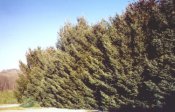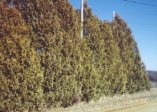Windbreaks Around the World.
Field windbreaks in Ukraine
I had the privilege of going on a farm tour with the Iowa Farm Bureau to Ukraine in 2013. Ukraine has more grade A land than any other county in Europe. What is the most remarkable to me was their Field Windbreaks from one end of the country to the other. These were put in by the order of Stalin, when the Ukraine was part of the USSR in the early 1950s, to reduce soil erosion and increase yields.
They are currently thriving and doing well and none of them are being taken out as these windbreaks are still part of the Government land and has not been given back to the people as the farmable land was after 1991. All these windbreaks are easy to view going to the Google earth website over the Ukraine and focusing in on any area of the country.
This picture was right outside the airport in Kiev, the main varieties in the windbreaks are: Lindens, Ash, Birch, Hackberry, Oaks, Maples, Elms, Horse Chestnut and Locust. Weedy trees such as Box elder and Amur maple has taken over some areas.
All the windbreaks are 4 or 5 rows of deciduous trees spaced 3 meters apart between rows, and 2 meters between trees in the row, and none of them contained any evergreens.
The windbreaks run North and South and East and West usually about 1/2 -1 mile between them
With Ukraine's very fertile deep soils, these windbreaks should help it stay the breadbasket of Europe by keeping its soil from blowing and washing away, preserving soil moisture, and keep drying winds off of the crop fields. Its crop yields and total quantity of feed grains continue to increase and has become a major competitor with the USA for grain stocks around the world.
Below is Windbreak of Salt Cedar that surround the Furnace Creek Resort in Death Valley, California.
On the other side of this windbreak the wind was blowing 30-40 MPH with lots of sand in the air. Salt Cedar is a beautiful tree and makes a great windbreak in desert/dry areas of the SW USA, but is considered invasive so is rarely now being planted.
According from the people who run the resort, they were put in during the 1930s and are getting very old and starting to deteriorate, but still doing a great job protecting the resort from wind and sand storms. There is actually a golf course here.







